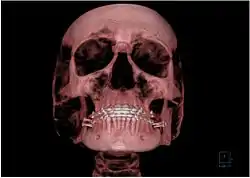Oral and maxillofacial radiology
Oral and maxillofacial radiology (OMFR), also known as dental and maxillofacial radiology (DMFR), is the specialty of dentistry concerned with performance and interpretation of diagnostic imaging used for examining the craniofacial, dental and adjacent structures.[1][2]

Oral and maxillofacial imaging includes cone beam CT, multislice CT, MRI, PET, ultrasound, panoramic radiography, cephalometric imaging, intra-oral imaging (e.g. bitewing, peri-apical and occlusal radiographs) in addition to special tests like sialographs. Other modalities, including optical coherence tomography are also under development for dental imaging.[3][4]
Training
United States
OMFR or DMFR is one of nine dental specialties recognized by the American Dental Association.[1][5]
To become an Oral and Maxillofacial Radiologist (OMFR) one must first complete a dental degree and then apply for and complete a postgraduate course of training (usually between 2–4 years in length).[6] Training includes all aspects of radiation physics, radiation biology, radiation safety, radiologic technique, the patho-physiology of disease and interpretation of diagnostic images.
The Commission on Dental Accreditation (CODA) accredited programs are a minimum of two years in length.[7] Several CODA accredited programs in OMFR require the resident to complete a graduate degree (MS), whereas others allow the option of pursuing a concurrent PhD or MS degree. Following successful completion of this training the Oral and Maxillofacial Radiologist becomes Board eligible to challenge the American Board of Oral and Maxillofacial Radiology examination. Successful completion of board certification results in Diplomat status in the American Board of Oral and Maxillofacial Radiology.
Australia
Australian programs are accredited by the Australian Dental Council (ADC) and are 3 years in length, culminating in either a master's degree (MDS or MPhil) or a Doctor of Clinical Dentistry degree (DClinDent).[8] Currently, the only Australian institution offering specialist training in OMFR is The University Of Queensland. Programs are focused on clinical radiology and offer comprehensive training with registrars reporting plain film, Cone Beam CT, Multislice CT and MRI of the maxillofacial region. Fellowship (FRANZCR) can then be acquired through the Royal Australia New Zealand College of Radiologists and/or the Royal Australasian College of Dental Surgeons (FRACDS/MRACDS DMFR). Oral and maxillofacial radiologists in Australia tend to work in the private sector, reporting in medical radiology practices alongside medical radiologists.
Canada
Canadian programs are accredited by the Canadian Dental Association (CDAC) and are a minimum of two years in length and usually culminate with a Master of Science (MSc) degree. Graduates are then eligible to sit for the Fellowship exams with the Royal College of Dentists of Canada (FRCD (C)).[9][10]
United Kingdom
Programs in the United Kingdom are 4 years in length and culminate in a Certificate in Completion of Specialty Training (CCST) and often a Master of Science degree (MSc). Graduates are then eligible to sit for the Diploma of Dental Radiology from the Royal College of Radiologists (FRCR DDR).[11]
During COVID-19 outbreak
The current coronavirus disease 2019 (COVID-19) outbreak has brought substantial challenges to the world health system, including the practice of dental and maxillofacial radiology (DMFR).[12]
A recently published rapid communication[12] has collected and evaluated all the best current evidence and published guidelines as well as professional recommendations to help maxillofacial radiologists and dental practitioners for safer radiological and imaging examinations on healthy, suspected, or confirmed COVID-19 patients during outbreak.Oral and Maxillofacial radiologists have an imperative role to play in the care of patients during COVID-19 pandemic. By managing relevant imaging strategies and infection control policies, radiologists, staff, and out- or inpatients will be safely protected from COVID-19 virus during outbreak.[12] Digital imaging and tele-consultations are emphasized to reduce the risk of cross-infection. DMFR professionals should follow-up COVID-19 patients after recovery for possible acute or chronic sialoadenitis.[12]
References
- "Specialty Definitions". American Dental Association. Retrieved 29 September 2019.
- "Oral Maxillofacial Radiology". Your Dentistry Guide. Retrieved 29 September 2019.
- Machoy M, Seeliger J, Szyszka-Sommerfeld L, Koprowski R, Gedrange T, Woźniak K (2017). "The Use of Optical Coherence Tomography in Dental Diagnostics: A State-of-the-Art Review". Journal of Healthcare Engineering. 2017: 7560645. doi:10.1155/2017/7560645. PMC 5534297. PMID 29065642.
- Shah N, Bansal N, Logani A (October 2014). "Recent advances in imaging technologies in dentistry". World Journal of Radiology. 6 (10): 794–807. doi:10.4329/wjr.v6.i10.794. PMC 4209425. PMID 25349663.
- Pakchoian AJ, Dagdeviren D, Kilham J, Mahdian M, Lurie A, Tadinada A (May 2015). "Oral and maxillofacial radiologists: career trends and specialty board certification status". Journal of Dental Education. 79 (5): 493–8. doi:10.1002/j.0022-0337.2015.79.5.tb05908.x. PMID 25941142.
- "Becoming an OMR". American Academy of Oral & Maxillofacial Radiology. Retrieved 29 September 2019.
- "Program Options & Descriptions". Commission on Dental Accreditation. Retrieved 29 September 2019.
- "Specialist Registration". Dental Board of Australia. Retrieved 29 September 2019.
- "National Dental Specialty Examination". Royal College of Dentists of Canada. Retrieved 29 September 2019.
- Kennedy DB (2001). "The Royal College of Dentists of Canada: History, Misconceptions and Recent Developments". Journal of the Canadian Dental Association. 67 (10): 574–6. PMID 11737978.
- "Education and Training". British Society of Dental and Maxillofacial Radiology. Retrieved 29 September 2019.
- Hamedani S, Farshidfar N (July 2020). "The practice of oral and maxillofacial radiology during COVID-19 outbreak". Oral Radiology. doi:10.1007/s11282-020-00465-8. PMC 7338339. PMID 32638200.